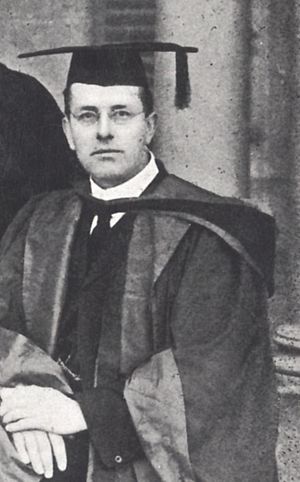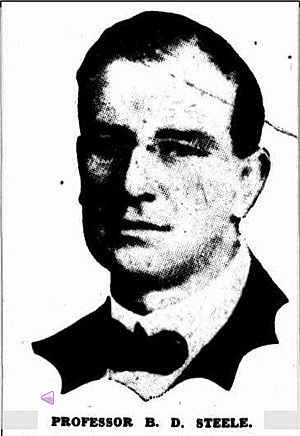Bertram Steele facts for kids
Quick facts for kids
Bertram Dillon Steele
|
|
|---|---|

Steele in 1911
|
|
| Born | 30 May 1870 Plymouth, Devon, England
|
| Died | 12 April 1934 (aged 63) |
| Alma mater | Victorian College of Pharmacy, University of Melbourne, |
| Scientific career | |
| Fields | Chemist |
Bertram Dillon Steele FRS (born May 30, 1870 – died April 12, 1934) was an important Australian scientist. He became the first professor of chemistry at the University of Queensland.
Contents
Early Life and Education
Bertram Steele was born in Plymouth, England. His father, Samuel Madden Steele, was a surgeon. Bertram first trained to follow in his father's footsteps.
In 1889, Steele moved to Australia. He studied at the Victorian College of Pharmacy. In 1890, he earned a gold medal for his studies. After that, he worked as a pharmacist.
A Brilliant Scientific Career
In 1896, Steele decided to study science. He enrolled at the University of Melbourne. Even as a second-year student, he was very good. He became a chemistry lecturer at three colleges.
University Studies and Early Research
Steele earned his science degree in 1898. He received top honors in chemistry. He also won several important scholarships. In 1899, he worked as a chemistry professor at the University of Adelaide. He then traveled to Europe to continue his research.
He worked with famous scientists like Professor J. Norman Collie and Sir William Ramsay. He also studied in Germany. In 1902, the University of Melbourne gave him a D.Sc. degree. This was a very high honor.
Steele later became an assistant professor in Scotland. In 1905, he returned to the University of Melbourne. There, he became a senior lecturer in chemistry.
Inventing the Micro-Balance
While at Melbourne, Steele worked with Kerr Grant. Together, they built a special device. It was called a micro-balance. This balance was incredibly sensitive. It could measure tiny amounts, like 4 nanograms.
Their invention was very important. It helped other scientists do amazing research. For example, it helped measure the density of Radium emanation.
Leading Chemistry in Queensland
On December 20, 1910, Steele got a big new job. He became the first professor of chemistry at the new University of Queensland. His experience was very helpful. He helped set up the university's science programs.
Helping During Wartime
Steele's academic work was paused during World War I. From 1915, he worked for the British government. He helped develop new technologies. He created a new type of protective mask. He also invented something to help against underwater threats.
He also found a way to make a chemical called phenol much cheaper. This was very important for the war effort. He designed a large factory to produce it. Steele refused extra pay for his work. He also turned down honors. He simply wanted to help his country. He later worked on other important defense projects.
After the war, Steele received special thanks. Important leaders like Winston Churchill thanked him. He returned to the university in 1919. That same year, he was elected a Fellow of the Royal Society in London. This is a very high honor for scientists.
Later Life and Lasting Impact
Steele worked very hard during the war. This strain affected his health. He retired from his teaching job in 1931. He lived in Brisbane until he passed away in 1934. He had no children.
Steele was known for being kind and unselfish. He was a tireless worker. He was also an ideal researcher. He was honest, patient, and imaginative. He helped solve a major problem in Queensland. He led a group that found a way to control the spread of prickly pear. This plant was a big danger to the land.
His Legacy Lives On
A major building at the University of Queensland is named after him. It is called the Steele Building. Also, an annual lecture is given in his name. This lecture series started in 1982. It continues to honor his contributions to science.


